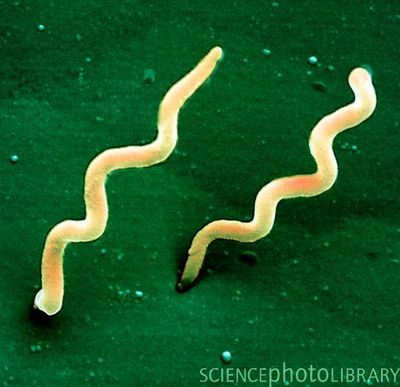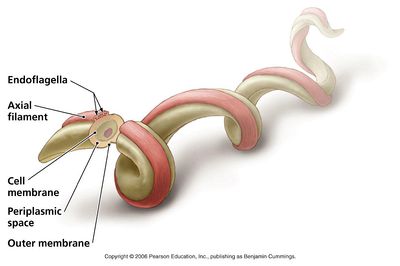Borrelia burgdorferi NEU2011: Difference between revisions
ChojnowskaA (talk | contribs) |
ChojnowskaA (talk | contribs) |
||
| Line 35: | Line 35: | ||
[[File:21-MAAG1 Treponema L.jpeg|400px|thumb|left|Spirochete Cell Structure. Image Courtesy of Pearson Education]]The cell consists of a protoplasmic cylinder that includes the genome and cytoplasmic membrane, all enclosed by a flexible multilayered envelope. The cells have 5-7 coils and contain anywhere from 7-20 endoflagella, that are embedded in the periplasm and are located at each pole (4). The machinery used in motility is similar to other bacteria in that it has a filament, hook and basal body (6). | [[File:21-MAAG1 Treponema L.jpeg|400px|thumb|left|Spirochete Cell Structure. Image Courtesy of Pearson Education]]The cell consists of a protoplasmic cylinder that includes the genome and cytoplasmic membrane, all enclosed by a flexible multilayered envelope. The cells have 5-7 coils and contain anywhere from 7-20 endoflagella, that are embedded in the periplasm and are located at each pole (4). The machinery used in motility is similar to other bacteria in that it has a filament, hook and basal body (6). | ||
B. burgdorferi is classified as a microaerophilic chemoorganotroph; they derive energy from metabolizing organic molecules and require oxygen to survive, but in very low concentrations. They are known to have very limited metabolic capacity and are therefore difficult to culture in the lab | B. burgdorferi is classified as a microaerophilic chemoorganotroph; they derive energy from metabolizing organic molecules and require oxygen to survive, but in very low concentrations. They are known to have very limited metabolic capacity and are therefore difficult to culture in the lab (6). | ||
== Ecology == | == Ecology == | ||
Revision as of 06:15, 1 April 2011
Borrelia burgforferi NEU2011
A Microbial Biorealm page on the genus Borrelia burgdorferi NEU2011
Classification
Higher order taxa
Domain- Bacteria
Phylum- Spirochaetes
Class- Spirochaetes
Order- Spirochaetales
Family- Spirochaetaceae
Genus- Borrelia
Species- Borellia burgdorferi
Description and Significance
Borellia burgdorferi is a spirochete which are cells that are both gram-negative and spiral-shaped with endoflagellum. The study of Borellia burgdorferi is very significant because it is the tick-borne agent of Lyme disease. Lyme disease is carried out by the bacterium, and transmitted through a variety of deer ticks, including Ixodes dammini (2). The disease was first discovered in 1982, by Willy Burgdorfer. He isolated spirochetes from the mid guts of Ixodes ticks and demonstrated that spirochetes and the immune serum reacted together from patients who were diagnosed with Lyme disease. Symptoms of the disease consist of inflammation all around the body, arthritis, heart problems and it can also affect the nervous system (8). Researchers have been studying Lyme disease for a decade after they discovered the complete genome sequence for B. burgdorferi strain 31. Recently researchers determined the whole genome sequences of thirteen isolates of B. Burgdorferi. The significance of this discovery proves that researchers will be able to improve on the understanding of its pathogenesis, and provide prevention strategies in the near future (7).
Genome Structure
The Borrelia burgdorferi genome contains 1.44 Mega base pairs with the number of G+C bases totaling 28%. It has a total of 22 DNA molecules including 21 extrachromosomal DNA elements, the largest known number of any bacterium (1). These include 12 linear and 9 circular plasmids which range from 5 to 56 kilobases (3). The plasmids contain a total of 1706 genes, including many pseudogenes, which suggests that the genome is actively evolving. It is also one of the few known bacteria to have a linear chromosome. Studies have shown that the linear plasmids have covalently closed ends, which occurs in some animal viruses but has not been found in prokaryotic organisms (5).
Cell Structure and Metabolism
The cell consists of a protoplasmic cylinder that includes the genome and cytoplasmic membrane, all enclosed by a flexible multilayered envelope. The cells have 5-7 coils and contain anywhere from 7-20 endoflagella, that are embedded in the periplasm and are located at each pole (4). The machinery used in motility is similar to other bacteria in that it has a filament, hook and basal body (6).
B. burgdorferi is classified as a microaerophilic chemoorganotroph; they derive energy from metabolizing organic molecules and require oxygen to survive, but in very low concentrations. They are known to have very limited metabolic capacity and are therefore difficult to culture in the lab (6).
Ecology
The white footed mouse, Peromyscus leucopus, is said to be the main carrier of Borrelia burgdorferi. However, it is also found in other small mammals and birds. Ticks acquire the bacteria by feeding on the blood of infected mammals and birds. Subsequently, they act as a reservoir and can transmit it further to other animals, including humans. (2)
Borrelia burgdorferi and significantly most of the spirochaetes falling under the B. burgdorferi species complex all migrate among varying transmitting ticks. Depending on the region of the world, the certain species of tick varies, and there are four more profound species that carry the spirochete bacteria. In eastern North America the bacterium resides in guts of the species of tick Ixodes scapularis, in western North America they thrive in the guts of Ixodes pacificus, in northern mid Asia they live in Ixodes persulcatus, and in Europe and surrounding areas the bacterium is dormant in the Ixodes ricinus. As far as the host in which bacterium is then transmitted, that spectrum is vary wide because the bacterium can be hosted by a broad variety of vertebrates. Once transmitted, they can reside and take on their pathogenic affects in vertebrates animals from insectivores, rodents, lagomorphs, ungulates, some birds, and a few species of reptiles.
Pathology
Borrelia burgdorferi is a very pathogenic agent. There are known stages to Lyme disease, but though there are different pathogenic effects, each contaminating case of the disease doesn’t follow a step-by-step process where one negative effect proceeds another. As stated earlier, many vertebrates may lay host to the bacterium, but for humans, the pathogenic symptoms are very distinct in comparison so lesser complex vertebrates. When a human is initially bite by a lyme disease carrying tick, the site of bite is compacted with a skin disorder known as Erythema migrans, and this creates a red ring, almost like a circular target at the bite. Not only does the carrying vector of the bacterium vary from region to region, the pathogenic effects differ as well. Problematic effects take course on the nervous system, heart, and musculoskeletal system, each bringing about separate downfalls of these systems depending on the area of the world sometimes.
Current Research
Insert text here
Cool Factor
Insert text here
References
1. Casjens, S., Palmer, N., Van Vugt, R., Mun Huang, W., Stevenson, B., Rosa, P., Lathigra, R., Sutton, G., Peterson, J., Dodson, R. J., Haft, D., Hickey, E., Gwinn, M., White, O. and M. Fraser, C. (2000), A bacterial genome in flux: the twelve linear and nine circular extrachromosomal DNAs in an infectious isolate of the Lyme disease spirochete Borrelia burgdorferi. Molecular Microbiology, 35: 490–516. doi: 10.1046/j.1365-2958.2000.01698.x
2. Meyerhoff, John O. 2009. Lyme Disease Causes and Transmission. E-Medicine from WebMD, New York, NY: Healthwise Publishing.
3. Norris, Steven J. 2006. The dynamic proteome of Lyme disease Borrelia. Genome Biology, 7:209 doi:10.1186/gb-2006-7-3-209.
4. Madigan MT, Martinko JM, Dunlap PV, Clark DP. 2009. Brock Biology of Microorganisms. Twelfth Edition. San Francisco, CA: Pearson/Benjamin Cummings.
5. Barbour AG, Garon CF. July 1987. Linear plasmids of the bacterium Borrelia burgdorferi have covalently closed ends. Science Magazine, Vol. 237 no. 4813 pp. 409-411 DOI: 10.1126/science.3603026
6. Kahl O, Lane RS, Stanek G. 2002. Lyme Borreliosis : Biology, Epidemiology and Control. New York, NY: CABI Publishing.
7. Schutzer SE. 2011. Whole genome sequences of Borellia Burgdorferi. Journal of Bacteriology. 4:193 doi:10.1128/JB.01158-10.
8. Sternbach G, Dibble CL. 1996. Willy Burgdorfer: Lyme Disease. Journal of Emergency Medicine. 4:631



